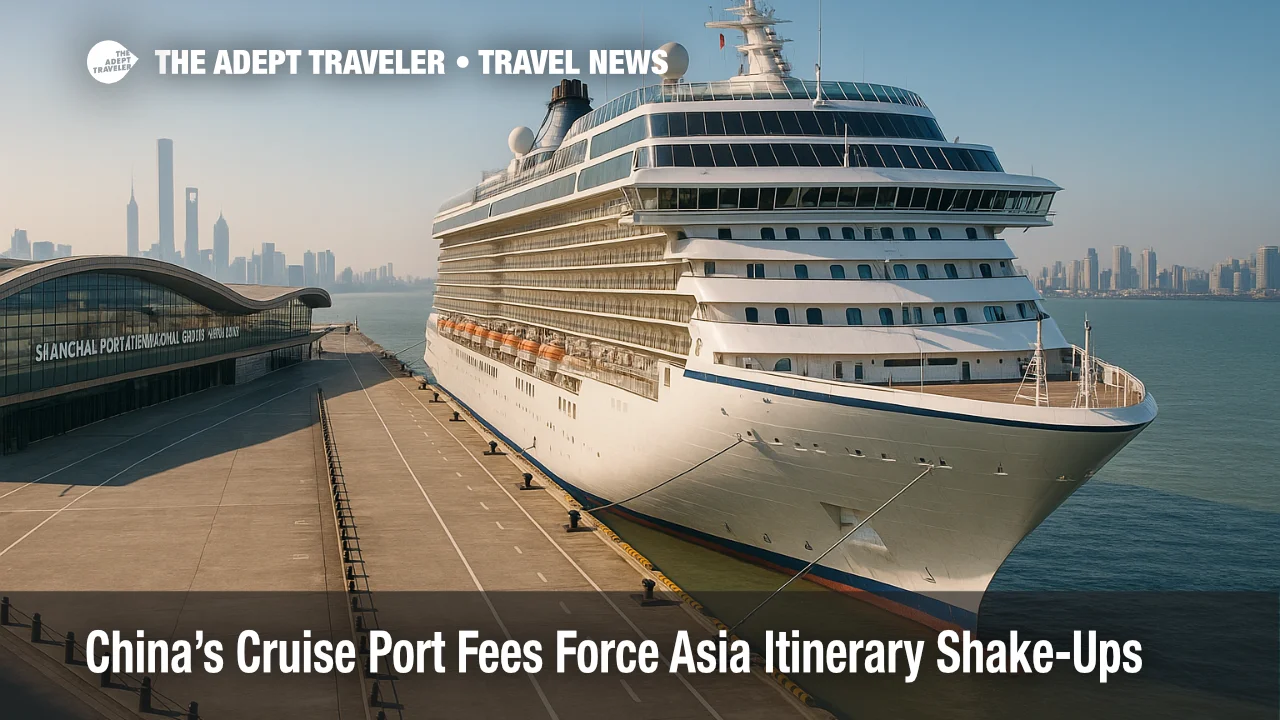China's cruise port fees force Asia itinerary shake-ups

Key points
- China cruise port fees took effect October 14, 2025
- Riviera skipped Shanghai to avoid about $1.6 million in fees
- Spectrum of the Seas received a waiver while homeporting in Shanghai
- Rates start near $56 per net ton, rising to about $157 by 2028
- Foreign itineraries with China calls face higher cancellation risk
China's new special port fees on U.S.-linked ships took effect on October 14, 2025, and the ripple effects hit cruise itineraries within days. Oceania Cruises' Riviera skipped a scheduled stop in Shanghai to avoid roughly $1.6 million in added charges, diverting to Busan instead, while Royal Caribbean's Spectrum of the Seas returned to Shanghai after receiving a waiver. With rates starting near 400 yuan per net ton, and set to rise sharply through 2028, cruise lines are already reassessing the viability of Chinese calls. For travelers, that means more last-minute changes, altered shore plans, and fine-print surprises on refunds and credits.
China's fee framework, and who gets hit
Beijing's Ministry of Transport confirmed it will charge a "special port fee" on ships with U.S. links, including those owned, operated, flagged, or built in the United States. The charge is assessed per voyage at the first Chinese port of call, capped at five voyages per vessel per year. It begins at 400 yuan, about $56, per net ton on October 14, 2025, stepping up to 1,120 yuan, about $157, per net ton by April 17, 2028. Chinese-built ships tied to otherwise in-scope categories may receive exemptions, and authorities have already shown willingness to issue waivers for vessels homeporting in China, as seen with Spectrum of the Seas. These rules mirror, in scope and timing, new U.S. fees targeting China-linked vessels that also begin this fall.
Latest developments
On October 16, Oceania Cruises' 66,000-ton Riviera removed Shanghai from its two-week itinerary rather than incur about $1.6 million in fees, substituting Busan. The next day, Royal Caribbean's Shanghai-based Spectrum of the Seas completed its short voyage and returned to its homeport after authorities granted a waiver. Industry reporting suggests waivers are not blanket approvals for all cruise ships, and that foreign-based itineraries adding Chinese calls are unlikely to qualify. Disney Cruise Line's previously expected Shanghai calls are now described as unlikely to proceed. MSC Cruises' Bellissima, owned by a Swiss company and registered in Malta, is currently homeporting in Shanghai and not subject to the new fees.
Analysis
Expect more Asia sailings to trim or drop Chinese calls unless a ship is homeported in China and operating primarily for the local market. The math is punishing at scale. Using the fee schedule at about $56 per net ton today, a large ship such as Spectrum of the Seas would face more than $9 million per visit, rising above $26.5 million once the rate reaches about $157 per net ton in 2028. Lines will weigh those costs against demand for Shanghai and Tianjin calls, the availability of Korean or Japanese alternates, and brand exposure goals in mainland China.
For travelers, the practical playbook is straightforward. If your must-see is Shanghai, favor ships based there, which have a better chance of exemption. Otherwise, book itineraries that either avoid China or are sold with flexible call lists in Northeast Asia, and review your line's diversion and compensation policies before final payment. If a port is dropped, expect onboard credit or taxes and fees refunds to be the baseline; cash refunds for missed calls are less common. Air arrangements tied to a Chinese embarkation port deserve special scrutiny, since last-minute changes could shift embarkation or debarkation to Korea or Japan with limited notice.
Final thoughts
China cruise port fees arrived quickly and with teeth, and operators are already pruning Shanghai calls unless they homeport in mainland China. If your Asia cruise hinges on a China port, choose a homeported option or build in flexibility. If you prefer certainty, select routes in Japan and Korea that never planned a Chinese call. Either way, watch for updates as the fee ladder climbs toward 2028 and continue to verify how your line handles diversions tied to China cruise port fees.
Sources
- 交通运输部关于对美船舶收取船舶特别港务费的公告, Ministry of Transport of the People's Republic of China
- 交通运输部办公厅关于印发《对美船舶收取船舶特别港务费实施办法》, Ministry of Transport of the People's Republic of China
- Notice of Action and Proposed Action in Section 301 Investigation, Office of the U.S. Trade Representative
- Notice of Proposed Modification of Action in Section 301 Investigation, Office of the U.S. Trade Representative
- China is including cruise ships in its new "special port fees", The Maritime Executive
- Luxury U.S. cruise ship skips Shanghai over China's new port charges, Caixin Global
- China begins charging port fees for U.S. ships, Reuters
- China imposes special port fees on U.S.-linked vessels, BIMCO
